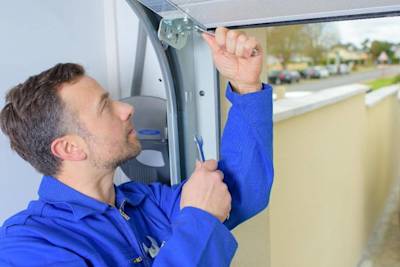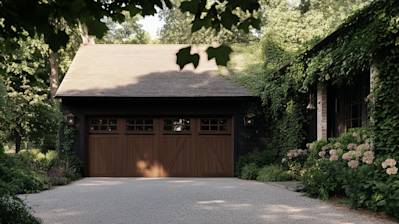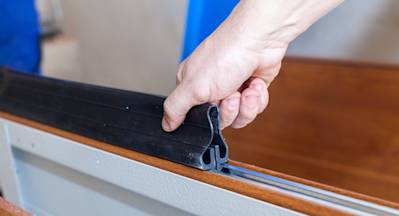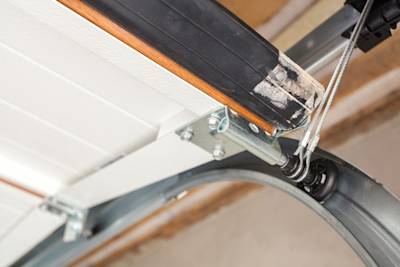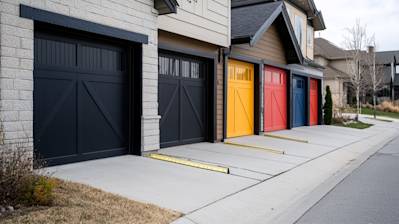Garage doors are an indispensable part of our homes, safeguarding our vehicles and other valuable items. One vital component of the garage door system that often gets overlooked is the garage door track. This article will delve into everything you need to know about garage door tracks.
What is a Garage Door Track?
The garage door track is an essential part of your garage door system. This metal guide's primary function is to direct and control the movement of the garage door as it opens and closes. Without this vital component, your door would simply not be able to move correctly.
Types of Garage Door Tracks
Garage door tracks come in various types to suit different architectural designs and spaces:
Standard Lift Track: This is the most common track type used in residential homes. It makes use of a straight vertical track lifted into a curved part, heading back into the garage.
Vertical Lift Track: Often used in commercial and industrial settings, this track type allows the door to rise vertically, parallel to the walls.
High Lift Track: This is a hybrid of the standard lift and vertical lift tracks, designed to maximize the overhead space in the garage.
Essential Components of a Garage Door Track
Let's delve into the key components of a garage door track:
Vertical Tracks: These guide the door to move upward and downward.
Horizontal Tracks: These direct the door back into the garage and are often attached to the ceiling or to the rear hangers.
Jamb Brackets: The brackets affix the vertical tracks to the garage door frame.
Track Bolts and Nuts: These secure the track sections.
Flag Bracket: This attaches the vertical and horizontal tracks.
Maintaining Your Garage Door Track
To ensure optimal performance and longevity, it's crucial to properly maintain your garage door track. Here are some key steps you can follow:
- Clean the Tracks: Use a damp cloth to clean the inside of the tracks, removing any accumulated dirt and dust.
- Inspect for Damage: Check for signs of wear or damage such as bends or misalignment. Regular inspections can help prevent severe issues down the line.
- Lubricate the Tracks: Apply lubrication regularly to the tracks for smoother operation. Use a silicone-based lubricant, which does not attract dirt or dust.
- Tighten the Bolts and Brackets: Loose bolts and brackets can cause the door to go off-track. Ensure these are adequately tightened.
Why You Might Need to Replace Your Garage Door Track
The garage door track plays a pivotal role in the proper functioning of your garage door. Reason for its replacement might include:
- Damage: Bends or warps in the track can cause your garage door to malfunction. Damages may result from accidents or severe weather conditions.
- Age: Over time, constant use takes a toll on the garage door track, resulting in wear and tear.
- Lack of Maintenance: Regular cleaning and lubrication can prolong the life of your garage door tracks. Neglect of such maintenance can lead to a reduced lifespan.
Frequently Asked Questions about Garage Door Track
How Does a Garage Door Track Work?
A garage door track works by guiding the garage door during opening and closing processes. The track is designed to hold the garage door rollers, enabling smooth and seamless operation. When you open your garage door, the electric motor lifts the door, and the rollers on the door move along these tracks, guiding the door vertically and horizontally.
How to Adjust a Garage Door Track?
Adjusting your garage door track can be a simple process. First, make sure to shut down the garage door for safety. Use a level to determine if the track is at the right setting. If not, loosen the track brackets and adjust accordingly. Always remember to test the door's operation after an adjustment, and if you're not comfortable doing it yourself, it's best to hire a professional.
How Do I Know If My Garage Door Track Needs Repairs?
Signs that your garage door track might need repairs include loud or squeaky noises when opening or closing the door, door misalignment, irregular door movement, or if the door stops operating altogether. If you notice any of these issues, it is highly recommended to have your garage door track inspected by a professional.
How Do I Choose the Right Track for My Garage Door?
Choosing the right track for your garage door depends on the ceiling height, the type of garage door, and the available space. Consult a professional to understand your options based on these factors and to determine the best track for your unique situation.
Can I Replace a Garage Door Track Myself?
Yes, you can, but it requires some DIY know-how and tools. For safety reasons, it's best to have someone assist you. Keep in mind, the process involves heavy lifting and precise alignment. If you don't feel confident in carrying out this task or if the track is severely damaged, it's more advisable to call a professional.
What Is the Average Lifespan of a Garage Door Track?
The average lifespan of a garage door track can vary greatly depending on the quality of installation, the door load, maintenance levels, and frequency of use. However, with regular maintenance and moderate use, a garage door track can last anywhere between 10-15 years.
Can I Lubricate the Garage Door Track on My Own?
Yes, lubricating your garage door track can help maintain its smooth operation. Use a non-silicone-based garage door lubricant to avoid attracting dust and debris. It's crucial not to over-lubricate as it can cause dirt and grime build-up.
How Much Does It Cost to Replace a Garage Door Track?
The cost of replacing a garage door track can vary based on the scope of the repair, the type of track, and labor costs. On average, the price can range from $100 to $500, including parts and labor. Always ask for a detailed quote from professionals to understand what's included in the cost.

Pros of Garage Door Tracks
Easy and Smooth Operation
Garage door tracks make the opening and closing of garage doors smooth and easy. The track's design allows for the door to either roll up or slide to the side with minimal effort. This convenience is particularly appreciated in adverse weather conditions as it speeds up the process of getting in or out of the garage.
Enhances Security
Garage door tracks play a significant role in enhancing garage security. Once the door is closed, it fits securely within the grooves of the track. This design makes it much more difficult for potential intruders to force the door open.
Durability
The materials used in garage door tracks, typically steel or reinforced aluminum, are incredibly durable. They can withstand extreme weather conditions and frequent use without wearing down. This durability means garage door tracks often last the lifetime of the door itself.
Versatility
Garage door tracks allow for the accommodation of multiple garage door styles and sizes. Whether it's a single-car or a three-car garage you're dealing with, there's a track that can accommodate your specific door. This versatility extends to your design preferences as well, be it modern, traditional, or rustic.
Cons of Garage Door Tracks
Risk of Rust and Corrosion
Garage door tracks, especially those made from steel, are at risk of rust and corrosion. This is especially true in areas with high humidity or salt air. Although preventive measures can be taken, it's still a constant worry for homeowners.
Impact on Aesthetic Appeal
While garage door tracks serve a functional purpose, they can have a negative impact on the aesthetic appeal of the garage. They tend to stand out and can clash with certain garage door designs, especially the more rustic or traditional styles.
Requires Regular Maintenance
While garage door tracks are generally durable, they still require regular maintenance to remain in optimal condition. This involves lubricating the tracks and checking for any signs of wear and tear. Failure to regularly maintain the tracks can lead to damage and eventual replacement.
Noise Production
Garage door tracks can sometime generate a significant amount of noise, especially when the garage door is being opened or closed. This noise can be a nuisance especially early in the morning or late at night. Furthermore, the noise can indicate an issue with the tracks, such as a need for lubrication or alignment.
Installation Complexity
Installing garage door tracks can be complex and usually requires professional assistance. Not only is this an additional cost, but it also means granting someone else access to your property. Additionally, a DIY installation, if not done correctly, could lead to damaging the door.
Require Space
The existence of the track necessitates a certain amount of clearance both alongside and above the door. As a result, they're perhaps not the best choice for smaller garages where every inch of space is precious.
Potential Issues with Opener
If a problem arises with the garage door opener, it's usually tied to the track. These can range from getting disconnected from the door, rust, bending, or even the door falling off the track. These issues could hinder the operation of the garage door, posing both an inconvenience and safety risk.
Myths and Misconceptions about Garage Door Tracks
Garage door tracks are integral parts of the overall garage door system. However, many homeowners and property managers misunderstand their operation, maintenance and repair. Let's debunk some common myths and misconceptions.
Myth 1: All Garage Door Tracks are the Same
One common misconception is that all garage door tracks are the same. This is not true. Garage door tracks come in different sizes suited to the size and type of the garage door. For instance, tracks for residential doors would be different from those used in commercial doors. Always confirm with a professional before replacing your garage door tracks.
Myth 1.1: Garage Door Tracks are Universal
Despite what some people believe, garage door tracks are not “one size fits all”. They are made in different lengths and sizes that are suitable for different types of doors. You can't use a double door track for a single door garage and vice versa.
Myth 2: Garage Door Tracks Require No Maintenance
Many homeowners believe that once installed, garage door tracks require no maintenance. This is a misconception. Garage door tracks should be properly maintained to help them perform efficiently and for a longer period of time. This might include; regular cleaning to remove dirt and debris, inspecting the tracks for dents or other damages, lubricating the tracks, and tightening loose components.
Myth 2.1: Lubricating the Tracks Often is Good
While lubricating garage door tracks is crucial for their smooth operation, doing it too often can cause issues. Excessive lubrication might attract and retain dirt and debris. This could interfere with the door's operation causing it to stick or become noisy. Lubrication should be done sparingly and only when necessary.
Myth 3: Garage Door Tracks can be Installed DIY
It is a common misconception that installing garage door tracks is a DIY job. While it might seem easy, the process can be quite complex and challenging. It requires technical know-how, the right tools, and safety precautions. Attempting to install the tracks without the necessary expertise might lead to not only an improper installation but also injury. This task is best left to professionals.
Myth 3.1: It Won't Make a Difference If The Tracks Aren't Aligned
The belief that the alignment of the garage door tracks doesn't significantly affect the door's performance is false. Misaligned tracks can cause the door to jam or not operate at all. Always make sure tracks are properly aligned during installation and thereafter.
Myth 4: Dented Garage Door Tracks Don’t Affect Door Operation
A dent or bend in the track may seem insignificant, but it can majorly affect your garage door operation. Some people falsely believe that just because the door can still move up and down a dented track, that it isn't a problem. This is incorrect as over time, the bent track might prevent the door from opening and closing smoothly, and in some cases might even cause it to derail.
Myth 5: Garage Door Tracks are the Cause for Every Door Malfunction
While garage door track issues can cause your door to malfunction, it's a misconception to believe tracks are the cause of all problems. Other components of a garage door like springs, rollers, or the opener can also be at fault. It always pays to have an expert inspect and diagnose issue accurately.
Myth 5.1: A Garage Door Always Needs A New Track If It's Not Closing
The idea that a non-closing door always implies a track replacement is flawed. Problems with sensors or the door opener could prevent the door from closing properly. Inspect these components before deciding on track replacement.
Having an understanding of these myths and misconceptions can help you to better care for your garage door and ensure it's longevity. Always approach a professional with experience for maintaining or fixing your garage door to avoid any future mishaps.
Summary
So, let's wrap up our chatter about the garage door track. It's pretty clear that this often-overlooked component plays a critical role in the smooth, safe operation of your garage door. Whether you have a brand new state-of-the-art model, or your loyal, decade-old one, the track should be properly aligned and maintained. Should you find it bent, rusted, or damaged in any way, don't hesitate to call a professional. Conducting regular checks on your garage door track ensures it stays in top notch condition and prolongs the life of your entire garage door system too.
Think of your garage door track as the highway for your door. It's the path that your garage door travels up and down day after day, and it's the guide that keeps everything moving smoothly without wandering off course. That's an important job, right? So never take the state of your garage door track for granted. It deserves just as much attention as the rest of your garage door parts – rollers, springs, and cables. After all, the track is as essential for your garage door's operation as our highways are for our daily commutes.
And remember, folks: dealing with any issues related to the garage door track isn’t a DIY job. Although it might be tempting to attempt repairs or adjustments yourself, it's best left to the professionals. The track is carefully aligned with the garage door system and interfering with this alignment can lead to serious damage of your door or even pose a safety hazard. So, next time you encounter problems with your ‘underappreciated’ garage door track, don't hesitate to call in a pro! It'll save you hassle, money, and most importantly, ensure you and your family's safety.
About 1A Garage Doors
1A Garage Doors of Sacramento, CA is your neighborhood garage door expert, proudly serving our community for decades. Our commitment lies in delivering top-notch garage door repair, installation, and maintenance services, all with a friendly face. Our professional team blends years of experience with ultimate proficiency to ensure our clients' satisfaction. Whether it's a minor fix, a major overhaul, or a brand new garage door installation, we've got you covered. We believe in providing quality, reliability, and affordability in every job we undertake. Truly, with us, your garage door is in the best hands!



